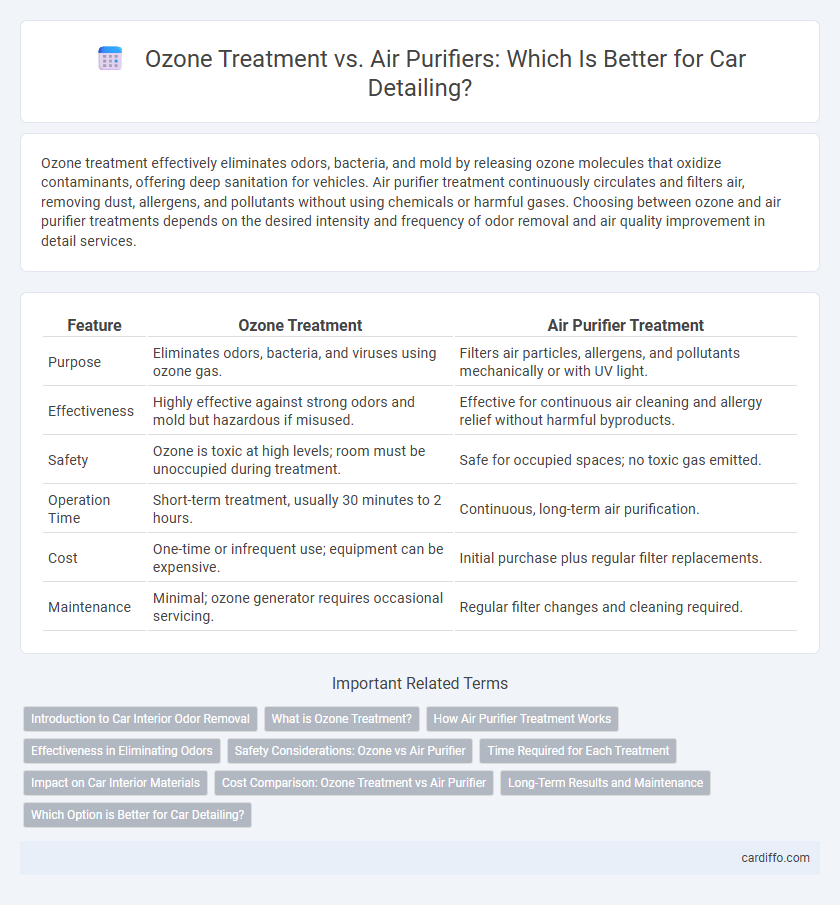Ozone treatment effectively eliminates odors, bacteria, and mold by releasing ozone molecules that oxidize contaminants, offering deep sanitation for vehicles. Air purifier treatment continuously circulates and filters air, removing dust, allergens, and pollutants without using chemicals or harmful gases. Choosing between ozone and air purifier treatments depends on the desired intensity and frequency of odor removal and air quality improvement in detail services.
Table of Comparison
| Feature | Ozone Treatment | Air Purifier Treatment |
|---|---|---|
| Purpose | Eliminates odors, bacteria, and viruses using ozone gas. | Filters air particles, allergens, and pollutants mechanically or with UV light. |
| Effectiveness | Highly effective against strong odors and mold but hazardous if misused. | Effective for continuous air cleaning and allergy relief without harmful byproducts. |
| Safety | Ozone is toxic at high levels; room must be unoccupied during treatment. | Safe for occupied spaces; no toxic gas emitted. |
| Operation Time | Short-term treatment, usually 30 minutes to 2 hours. | Continuous, long-term air purification. |
| Cost | One-time or infrequent use; equipment can be expensive. | Initial purchase plus regular filter replacements. |
| Maintenance | Minimal; ozone generator requires occasional servicing. | Regular filter changes and cleaning required. |
Introduction to Car Interior Odor Removal
Ozone treatment effectively eliminates stubborn car interior odors by oxidizing and neutralizing odor-causing molecules at a molecular level, making it ideal for smoke, mold, and pet smells. Air purifier treatment uses HEPA filters and activated carbon to capture airborne particles and absorb volatile organic compounds, improving air quality without chemicals. Both methods offer odor removal solutions, but ozone treatment provides deeper, more thorough decontamination of persistent interior smells.
What is Ozone Treatment?
Ozone treatment involves the use of ozone gas (O3) to eliminate odors, bacteria, viruses, and mold from indoor environments by breaking down pollutants at a molecular level. Unlike traditional air purifiers that filter airborne particles, ozone generators produce a reactive gas that penetrates hard-to-reach areas, providing thorough sanitation. This method is commonly used in detailing and restoration to neutralize strong odors and disinfect vehicle interiors without leaving chemical residues.
How Air Purifier Treatment Works
Air purifier treatment works by drawing air through a series of filters, including HEPA and activated carbon, to trap dust, allergens, and pollutants. Advanced models use UV-C light or ionizers to neutralize bacteria, viruses, and odors, enhancing indoor air quality. Continuous circulation and filtration reduce airborne contaminants, providing a safer and healthier environment compared to ozone treatment.
Effectiveness in Eliminating Odors
Ozone treatment effectively eliminates odors by oxidizing and neutralizing airborne contaminants and bacteria, often reaching areas that air purifiers cannot. Air purifier treatment primarily relies on filtration to trap particles and some odors but may struggle with deeply embedded or strong odors. Ozone's ability to break down odor-causing molecules makes it more powerful for comprehensive odor removal in detailing.
Safety Considerations: Ozone vs Air Purifier
Ozone treatment generates ozone molecules that can irritate respiratory systems and pose health risks if not properly controlled, requiring strict safety protocols during use. Air purifiers with HEPA filters effectively remove airborne particles without releasing harmful byproducts, offering a safer alternative for continuous indoor air quality improvement. Choosing air purifiers minimizes exposure to toxic ozone, making them preferable for environments with vulnerable populations such as children or individuals with asthma.
Time Required for Each Treatment
Ozone treatment typically requires 1 to 3 hours to effectively eliminate odors and contaminants, followed by a ventilation period of several hours to ensure safe re-entry. Air purifier treatment operates continuously, often needing 8 to 24 hours to significantly improve indoor air quality by filtering out particles and pollutants. The choice between ozone and air purifiers depends on the urgency and duration of air quality improvement needed.
Impact on Car Interior Materials
Ozone treatment effectively eliminates odors and bacteria in car interiors but can degrade leather, rubber, and plastic components over time due to its strong oxidative properties. Air purifier treatment, using HEPA and activated carbon filters, preserves interior materials by gently removing airborne contaminants without causing material wear or discoloration. Regular use of air purifiers ensures cleaner air while maintaining the integrity of sensitive surfaces in the vehicle cabin.
Cost Comparison: Ozone Treatment vs Air Purifier
Ozone treatment generally costs less upfront, with average prices ranging from $100 to $300 per session, making it a one-time expenditure for odor removal or sanitization. Air purifiers require an initial purchase of $150 to $600, plus ongoing costs for replacement filters every 6 to 12 months, which can add $50 to $150 annually. Considering long-term expenses, air purifiers tend to be more cost-effective for continuous air quality improvement, while ozone treatment is more budget-friendly for occasional use.
Long-Term Results and Maintenance
Ozone treatment offers powerful destruction of odors and contaminants but requires careful control due to potential health risks and material degradation over time. Air purifiers provide consistent long-term air quality improvement with minimal maintenance, using HEPA and activated carbon filters to capture pollutants effectively. Regular filter replacements and periodic cleaning ensure sustained performance of air purifiers, making them a safer and more manageable option for ongoing indoor air treatment.
Which Option is Better for Car Detailing?
Ozone treatment effectively eliminates odors and bacteria deep within car interiors by releasing ozone molecules that oxidize contaminants, making it ideal for severe odor issues and mold removal. Air purifier treatment continuously filters the air inside the vehicle using HEPA filters and activated carbon, maintaining clean air and reducing allergens during regular use. For intensive car detailing, ozone treatment offers a stronger, faster approach to odor and microbial elimination, while air purifiers provide ongoing air quality improvement with less chemical exposure.
Ozone Treatment vs Air Purifier Treatment Infographic

 cardiffo.com
cardiffo.com